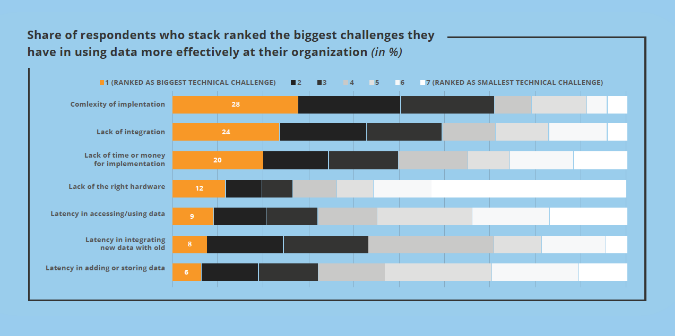Key takeaways from a new study on data’s role in decisions
[ad_1]
There is a developing hole in between the sum of data accessible and the critical selections that are being produced at each amount of an organization—and that “data decision gap” threatens to not only compromise the investments corporations continue on to make in digital transformation but result in those organizations to permit intuition alternatively than information and facts figure out their futures.
That is the more than-arching locating from a new report based on a study of 441 men and women whose professions rely on navigating the information selection hole. The report, which was generated by Manchester Street, also examines the challenges corporations deal with in closing the hole, and specifics why applications may well be the greatest option for narrowing the divide upfront.
Adhering to are three other crucial takeaways from the study, which Domo commissioned and a large selection of business enterprise leaders participated in.
1 – The struggle (to come to be data-driven) is actual
Businesses that are definitely details-pushed employ insights for decision-building at all levels, from the C-suite to the frontline and know-how employees. The problem is, handful of businesses commit to additional than just capturing, storing, and getting access to knowledge. In truth, when asked, “How considerably of your org normally takes benefit of insights derived from information analytics or BI?”, the top reaction was “40-60%”.
So, what is holding these businesses again from bridging the hole between getting obtain to knowledge and placing information to use? In short: a selection of worries. A lot of businesses deal with attitudinal and/or technical difficulties (see chart down below). But the two most important factors for the gap, according to the respondents, is that the applications are far too disconnected from the business, and lack of training.
This can make perception, because if the equipment are disconnected from the organization, then it is tricky to justify the time and cash to conduct teaching. So, as a substitute, businesses continue to depend on analysts when they could be creating facts more obtainable to all and pushing technical perform downstream to expertise staff.

2 – The foreseeable future is vibrant … with the appropriate equipment
Inspite of the complications involved with predicting what the long run might glance like for their corporations, the respondents overwhelmingly articulated a eyesight based on substantial—and, in quite a few situations, exponential—potential for the function of data.
For case in point, 57% claimed that equipment mastering, artificial intelligence, and/or info science will most likely get significant or exponential investments about time.
These leaders identify that they are unable to simply just invest in far more storage and hope that the information issue will take care of by itself. As a substitute, they must make investments in resources that:
- can respond to the elevated resources of details
- are simple to use
- can easily integrate with present workflow procedures
- do not have to have comprehensive teaching
With these tools, the lid on who can make information-pushed selections receives eliminated, which is how an organizational culture can begin to change.
3 – Apps are wherever it’s at
The respondents propose that there are three essential properties for any device that promises to support facts-pushed selection-generating.
Initially, the software must assist the integration, automation, and accessibility of data, simply because, as earlier pointed out, companies not often have the time or cash to invest in comprehensive teaching to empower a superior proportion of their personnel to master facts science—and none can afford to proceed to depend on information analysts to make tips dependent on facts, which is the place 76% of respondents mentioned they are nevertheless in.
2nd, the software have to assistance anybody to develop apps—from no-code, interactive dashboards to unique applications designed by builders to solve company issues and automate workflows—as acquiring this sort of a functionality fosters a greater degree of employee empowerment.
And 3rd, the tool ought to prioritize customizable apps that are cell-welcoming. This makes sure usability. Cell-pleasant applications permit staff members to do the job seamlessly throughout devices, collaborate across departments, and make quick choices dependent on actual-time data accessible at their fingertips.
The best solution
There is a incredible gap amongst what organizations say they do with details and what they essentially do with data—and the study info from a modern, Domo-sponsored research backs it up.
The fantastic news is that there are instruments that can enable organizations minimize this hole. One particular these kinds of software is the Domo system, which possesses all the functions that go into what the respondents described as their best technological alternative.
Apps are a major aspect of that resolution since, on the Domo platform at minimum, they are uncomplicated to make, simple to integrate with no disrupting existing workflows and processes, and effortless to use whether you are an analyst or not.
Download the report this weblog submit is centered on—Closing the Info Decision Hole: How the Appropriate Information Apps Can Empower Corporations to Turn into Really Information-Pushed—to discover more about the disconnect between facts and selections, and how it can be fastened.
[ad_2]
Source website link







